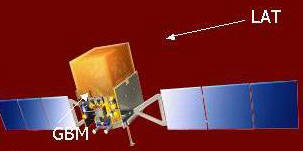
Dr. Mary Garrett, Educator/Ambassador for NASA’s GLAST Program
Return to Dr. Garrett's GLAST page


GLAST: The Story
 From
http://glast.gsfc.nasa.gov/ we can get
this brief overview:
From
http://glast.gsfc.nasa.gov/ we can get
this brief overview:"The Universe is home to numerous exotic and beautiful phenomena, some of which can generate almost inconceivable amounts of energy. Supermassive black holes, merging neutron stars, streams of hot gas moving close to the speed of light ... these are but a few of the marvels that generate gamma-ray radiation, the most energetic form of radiation, billions of times more energetic than the type of light visible to our eyes. What is happening to produce this much energy? What happens to the surrounding environment near these phenomena? How will studying these energetic objects add to our understanding of the very nature of the Universe and how it behaves?
The Gamma-ray Large Area Space Telescope (GLAST) will open this high-energy
world to exploration and help us to answer these questions. With GLAST,
astronomers will at long last have a superior tool to study how black holes,
notorious for pulling matter in, can accelerate jets of gas outward at fantastic
speeds. Physicists will be able to study subatomic particles at energies far
greater than those seen in ground-based particle accelerators. And cosmologists
will gain valuable information about the birth and early evolution of the
Universe. "
Return to top
There is an excellent summary of high energy objects to be found at: http://super.colorado.edu/~astr1020/lesson11.html . The table on that site can give you some historical perspective of the discoveries.
Radio-lobe Galaxies
From
http://cosmos.astroscu.unam.mx/~sergio/phdthesis/phdlatex2html/node9.html we learn that "In
the early 1900's, observations of the elliptical galaxy M87 (NGC 4486, 3C 274 or
Virgo A) carried out by Heber Curtis (Curtis,
1918) revealed a ``curious straight jet ... apparently
connected with the nucleus by a thin line of matter''. These optical
observations were not followed up by Curtis and it was not until the development
of radio astronomy in the 1960's that jets emanating from the nuclei of certain
galaxies became a major theme of research in astrophysics. "
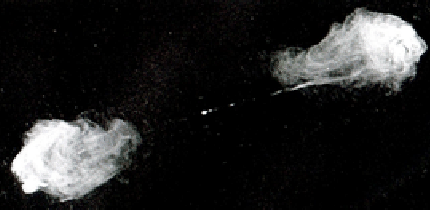 To the right you can see a "Figure I.1:high resolution image of the
archetypical powerful radio galaxy Cygnus A (3C 405) at
To the right you can see a "Figure I.1:high resolution image of the
archetypical powerful radio galaxy Cygnus A (3C 405) at
|
Seyfert Galaxies
From
http://www.goshen.edu/nasc/NaSc200/Notes/Galaxies/ActiveGalaxies.html we
learn "Carl Seyfert in the 1940's studied galaxies with peculiar nuclei. These
galaxies look like normal spiral galaxies in photographs, but have small
brilliant nuclei. The nucleus of a Seyfert can be 10,000 times brighter than the
center of our Galaxy. They have strong and broad emission lines in their
spectra. Recall that stars typically produce absorption lines in their spectra.
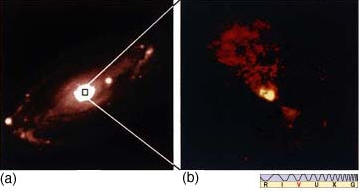 Absorption lines are seen
when we look through gas at a hot objects beyond. Emission lines are seen when
we look directly at hot gas. This means that Seyfert Galaxies have hot gas near
their nuclei. The lines are broad if the gas is moving at high velocities, so
that the Doppler effect (shifting to the red and to the blue) smears out the
lines.
Absorption lines are seen
when we look through gas at a hot objects beyond. Emission lines are seen when
we look directly at hot gas. This means that Seyfert Galaxies have hot gas near
their nuclei. The lines are broad if the gas is moving at high velocities, so
that the Doppler effect (shifting to the red and to the blue) smears out the
lines.
NGC5728
These photographs of a
 Seyfert galaxy (NGC 5728, about 40 Mpc away) (a) from the
ground and (b) from Earth orbit. View b is the small center area enlarged. There
are two lobes off of the center.
Seyfert galaxy (NGC 5728, about 40 Mpc away) (a) from the
ground and (b) from Earth orbit. View b is the small center area enlarged. There
are two lobes off of the center.
To the right you can see a different view of a Seyfert Galaxy.
You can click NGC1068 to see the central region of the Seyfert galaxy, NGC1068 (about 60 million LY away), taken by the Hubble Space Telescope. We can see clouds of gas visible at the center.
Another high energy object is space is the Blazar, an object that often
appears as a point-like source of bright, highly variable radiation.
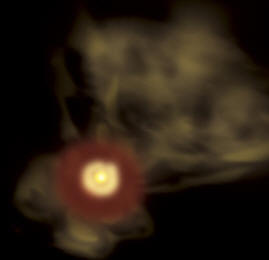
At
http://pc.astro.brandeis.edu/BRAG/people/ccc/work/ you can find a report by
a graduate student of another high energy item. |
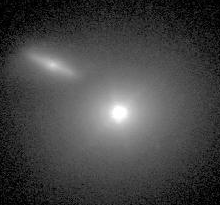 This image from http://www.gsfc.nasa.gov/topstory/2003/1212einstein.html shows an optical image of Markarian 421, a Blazar galaxy. |
As scientists studied the three types of high energy objects
described above, it appeared that these three types of object might really all
be the same type of object: an active galaxy. An active galaxy. In
the introduction of the document Active Galaxies at
http://www.goshen.edu/nasc/NaSc200/Notes/Galaxies/ActiveGalaxies.html we see
a comparison of galaxies and active galaxies: "All galaxies emit some
radio wave. Most normal galaxies emit radio waves that total only about 1% of
the galaxy's total luminosity. But some galaxies emit more than a million times
more radio energy than normal galaxies. These galaxies are called radio
galaxies. Some galaxies have unusual emission in the infrared, ultraviolet,
and x-ray region of the electromagnetic spectrum, so the term active galaxies
is also used. Since most of the emission seems to come from a small region in
the nucleus of these galaxies, these galaxies are said to have active
galactic nuclei (AGN)." The comparison summarized by Sarah Silva from
the NASA Educational Outreach Program at
Sonoma State
University states it succinctly as
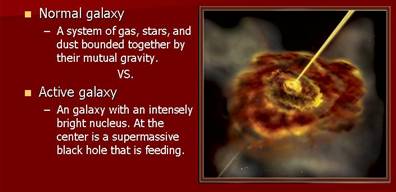
Active galaxies take many forms:
There are three common components of an active galaxy:
All these different flavors of galaxies may represent the same kind of object seen at different viewing angles.
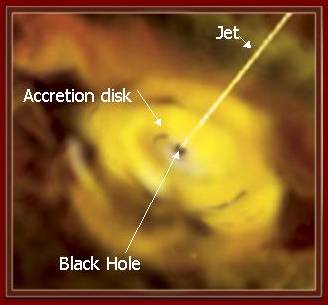  The
idea of unification for different types of active galactic nuclei is explained
at
http://cosmos.astroscu.unam.mx/~sergio/ The
idea of unification for different types of active galactic nuclei is explained
at
http://cosmos.astroscu.unam.mx/~sergio/phdthesis/phdlatex2html/node11.html. There it is explained "that projection effects must play an important role in the interpretation of some of these sources. Much effort has been expended in determining to what extent different types of AGN are simply different manifestations of the same object viewed from different angles. " To the left is a generic model for the nucleus of an active galaxy, which contains a supermassive but invisible black hole - the engine that powers the phenomena we see. To the right is a drawing of the parts of an Active Galaxy. |
Radio Lobes: view perpendicular to accretion disk
|
Seyfert: view at an angle to accretion disk
|
Labeled components
|
Blazar: view directly down a jet:
|
Mathematics can be used to create models of natural phenomenon to help us see possible relationships more clearly. The Active Galaxies Education Unit created as a part of NASA's Educational Outreach Program, provides teachers with a set of activities that guide students in looking at a model of an active galaxy to study it from different angles and see if we can support the unification for different types of active galactic nuclei by matching the views of mathematical models of active Galaxies to the three types of high energy objects observed.
In this exercise we looked at physical mathematics model to help us verify that active galaxies would look different enough when look at from different directions to be initially considered to be different objects. There are other types of mathematical models as well that help us understand complex things.
If you want to order NASA materials, the order site is: http://epo.sonoma.edu/orderformpublic.html.